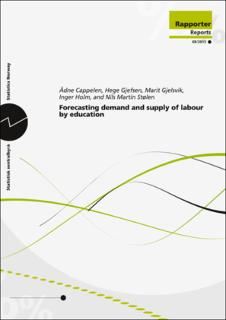Forecasting demand and supply of labour by education
Report
Permanent lenke
https://hdl.handle.net/11250/3119696Utgivelsesdato
2013-10Metadata
Vis full innførselSamlinger
- Rapporter / Reports (SSB) [1696]
Sammendrag
In Norway, supply of labour by level of education has developed in line with
demand for many years. At the same time unemployment rates and relative wages
for different educational groups have been quite stable over time. Stability in
relative unemployment and wages require that labour demand and supply match
well also in the future. Both for future students, employers and the authorities,
projections on demand and supply of labour by different kinds of education are
useful information. Students must decide on which subjects to study, for employers
it is important in their long-term planning, and the authorities must plan
educational capacity, industrial development and welfare reforms.
Statistics Norway has produced projections of supply and demand for labour by
different kinds of education since 1993. In this report, we present new projections up
to 2030. We use the macroeconomic model MODAG when projecting the demand
for labour. MODAG is a multi-sectoral macroeconomic model that captures linkages
between industries. Demand for labour by five educational groups is modelled for
each industry. The five groups are partly substitutes within each industry, and the
employment shares depend on relative wages and technological change. In addition,
there is a sub-model disaggregating employment by education and industry into
employment by 28 different fields of education. Previous observed trends are used to
divide projected demand for labour from the five groups into the 28 fields.
The projections show that the previous trends of increasing demand for workers
with a tertiary education and upper secondary vocational education will continue
towards 2030. A decreasing share of demand is directed towards primary, lower
secondary and upper secondary general education as the highest level of completed
education. For employees with education at the tertiary level, the projections show
a high growth in demand for most of the detailed educational fields, and
particularly for candidates in economics and administration and nursing and social
care at a lower level of tertiary education.
Supply of labour by the 28 different fields of education is projected by using the
dynamic microsimulation model MOSART. From a base year, MOSART simulates
the further life course for each person in the entire Norwegian population by using
estimated transition proba¬bilities. In the projections, the transition probabilities are
kept constant. This implies that educational propensities and labour force participation rates are constant as well. By comparing the projections of labour demand
from the MODAG simulations with the labour supply from the MOSART simulations, we get some indications of potential imbalances in the future labour market.
The projections show a higher increase in demand for labour with upper secondary
vocational education than the corresponding increase in supply. A relatively low
completion rate for this kind of education is an important factor behind the slow
growth in supply. The projections also indicate future excess demand for teachers
and nurses. On the other hand supply may increase more than demand for tertiary
educations in economics and administration, social sciences, law and humanities
and arts. Observed lack of engineers and persons with other fields of science seems
to be reduced because of improved completion rates for these educations.
The projections from this model system are uncertain both because the projection
period is quite long and because they are based on discussable assumptions. On the
demand side prolongation of previous trends regarding the composition of labour
in each industry is the most vital assumption, while assumptions of constant
transition probabilities are important for the projections of supply. Demand and
supply for the different fields of education are projected independently, and
mechanisms working to reduce future imbalances are not included. Therefore, the
results must be used with caution.

